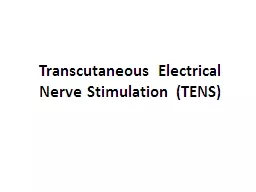

Definition Generally TENS is applied at high frequency gt50 Hz with an intensity below motor contraction sensory intensity or low frequency lt10 Hz with an intensity that produces motor contraction ID: 931770
Download Presentation The PPT/PDF document "Transcutaneous Electrical Nerve Stimulat..." is the property of its rightful owner. Permission is granted to download and print the materials on this web site for personal, non-commercial use only, and to display it on your personal computer provided you do not modify the materials and that you retain all copyright notices contained in the materials. By downloading content from our website, you accept the terms of this agreement.
Slide1
Transcutaneous Electrical Nerve Stimulation (TENS)
Slide2Definition
Generally TENS is applied at high frequency (>50 Hz) with an intensity below motor contraction (sensory intensity) or low frequency (<10 Hz) with an intensity that produces motor contraction.
Slide3Mechanism of Pain:
Pain is felt as a result of the brain's response to electrical (neural) and chemical (hormonal) changes in the body as a result of damage.
Signals from damage or injury are picked up by sensory receptors in nerve endings. The nerves then transmit the signal via the nerves to spinal cord and brain.
Slide4Mechanism of Pain:
Slide5Pain Relief:
Pain can be managed in the short term using analgesics, but long-term use can be detrimental to the patient's health.
Side effects of the long use of analgesics may affect on liver, kidney or stomach.
In many cases where pain is constant, a medical practitioner or physiotherapist may recommend the use of a TENS unit.
Why TENS?
Because it is safe, effective and virtually with no side effects.
Slide6Functions and Features of TENS:
A TENS unit provides electrical stimulation to the painful area using electrodes attached to the skin.
Some scientists say:
electrical signal
v
nerve sensation stops
v
natural pain relieving substances (endorphins)
v
no pain massages to brain
v
no pain.
Slide7Features:
1- Two different modes:
a- Continuous (continuous stream)
b- Intermittent (short bursts)
Usually the continuous mode is used but for long term treatment intermittent mode is used
2- Adjustable.
We can control three variables:
a- Output voltage.
b- Width of the pulses.
c- Pulse rate.
Slide8Slide9Slide10Slide11Slide12Slide13Slide14Slide15Therapeutic Uses of Electrical Stimulation of Sensory Nerves – Asymmetric Biphasic Currents (TENS)
Gate Control Theory
Descending Pain Control
Opiate Pain Control
Slide16Provide high frequency sensory level stimulation to stimulate peripheral sensory A
β
fibers and “close gate”
Referred to as conventional, high frequency or sensory-level TENS
Intensity is set at a level to cause tingling sensation without muscle contraction
Pain relief lasts only while stimulation is provided
TENS & Gate Control Theory
Slide17Intense electrical stimulation of smaller peripheral A
δ
and C fibers through input to the CNS causes a release of enkephalins blocking pain at the spinal cord level
Cognitive input from the cortex relative to past pain perception also contributes to this mechanism
Low-frequency or motor-level TENS is used
elicits tingling and muscle contraction
Provides pain relief >1 hour
TENS & Descending Pain Control
Slide18Noxious stimulus causes release of
β
–endorphins and dynorphin resulting in analgesia
A point stimulation set-up must be used
β
–endorphin stimulation may offer better relief for deep aching or chronic pain
Intensity of impulse is a function of pulse duration and amplitude
Greater pulse width is more painful
TENS & Endogenous Opiate Pain Control
Slide19Electrode Placement
Electrodes may be placed:
On or around the painful area
Over specific dermatomes,
myotomes
, or
sclerotomes
that correspond to the painful area
Over
trigger point locations
Slide20Mechanisms of Pain Control
Gate control theory
Descending mechanisms(Central Biasing)
Release of endogenous opioids (ß-endorphin)
Pain relief may result from combination of these 3 mechanisms
Slide21Gate Control Theory
Information from ascending
A
afferents and (pain messages) carried along
A
and C afferent fibers enter the dorsal horn
Slide22Gate Control Theory
Impulses stimulate the substantia gelatinosa at dorsal horn of the spinal cord inhibiting synaptic transmission in
A &
C fiber afferent pathways
Slide23Gate Control Theory
Sensory information coming from A
fibers is transmitted to higher centers in brain
“Pain message" carried along A
&
C fibers is not transmitted to second-order neurons and never reaches sensory centers
Slide24Descending Pain Control Mechanisms
Stimulation of descending pathways in the dorsolateral tract of the spinal cord by
A
and C fiber afferent input results in a “closing of the gate” to impulses carried along the
A
and C afferent fibers
Slide25Descending Pain Control Mechanisms (Central Biasing)
It is theorized that previous experiences, emotional influences, sensory perception, and other factors could influence transmission of pain message and perception of pain
Slide26Descending Pain Control Mechanisms
Ascending neural input from A
and C fiber afferents and possibly central biasing stimulates periaquductal grey region in midbrain which stimulates raphe nucleus in pons and medulla thus activating descending mechanism in dorsolateral tract
Slide27Descending Pain Control Mechanisms
Efferent fibers in dorso- lateral tract synapse with enkephalin interneurons
Serotonin is a neuro-transmitter
Interneurons release
enkephalin
into the dorsal horn, inhibiting the synaptic transmission of impulses to second-order afferent neurons
Slide28Descending Pain Control Mechanisms
A second descending, pathway projecting from the pons to the dorsal horn has been identified
Thought to inhibit transmission due to release of norepinephrine
Slide29-Endorphin and Dynorphin
Stimulation of A
and C afferents can stimulate release of endogenous opioid
ß-endorphin
from hypothalamus
Dynorphin
released from periaqueductal grey
Dynorphin
released
Slide30Mechanisms of Pain Control
The theories presented are only models
Pain control is the result of overlapping mechanisms
Useful in conceptualizing the perception of pain and pain relief
Slide31Pain Management
Therapeutic modalities can be used to
Stimulate large-diameter afferent fibers( TENS, massage, analgesic balms)
Decrease pain fiber transmission velocity (cold, ultrasound)
Stimulate small-diameter afferent fibers and descending pain control mechanisms (accupressure, deep massage, TENS)
Slide32Pain Management
Therapeutic modalities can be used to
Stimulate release of endogenous opioids through prolonged small diameter fiber stimulation with TENS